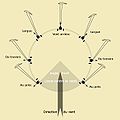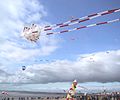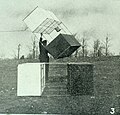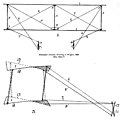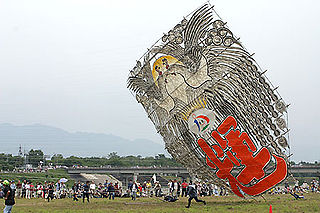
A kite is a tethered heavier-than-air or lighter-than-air craft with wing surfaces that react against the air to create lift and drag forces. A kite consists of wings, tethers and anchors. Kites often have a bridle and tail to guide the face of the kite so the wind can lift it. Some kite designs do not need a bridle; box kites can have a single attachment point. A kite may have fixed or moving anchors that can balance the kite. The name is derived from the kite, the hovering bird of prey.

Unpowered aircraft can remain airborne for a significant period of time without onboard propulsion. They can be classified as gliders, lighter-than-air balloons and tethered kites. In the case of kites, lift is obtained by tethering to a fixed or moving object, perhaps another kite, to obtain a flow of wind over the lifting surfaces. In the case of balloons, lift is obtained through inherent buoyancy and the balloon may or may not be tethered. Free balloon flight has little directional control. Gliding aircraft include sailplanes, hang gliders, and paragliders that have full directional control in free flight.
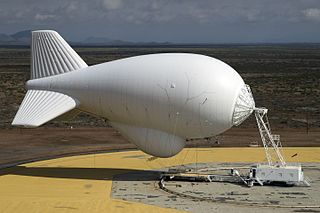
An aerostat is a lighter-than-air aircraft that gains its lift through the use of a buoyant gas. Aerostats include unpowered balloons and powered airships. A balloon may be free-flying or tethered. The average density of the craft is lower than the density of atmospheric air, because its main component is one or more gasbags, a lightweight skin containing a lifting gas to provide buoyancy, to which other components such as a gondola containing equipment or people are attached. Especially with airships, the gasbags are often protected by an outer envelope.

An airborne wind turbine is a design concept for a wind turbine with a rotor supported in the air without a tower, thus benefiting from the higher velocity and persistence of wind at high altitudes, while avoiding the expense of tower construction, or the need for slip rings or yaw mechanism. An electrical generator may be on the ground or airborne. Challenges include safely suspending and maintaining turbines hundreds of meters off the ground in high winds and storms, transferring the harvested and/or generated power back to earth, and interference with aviation.

Kiteboating or kite boating is the act of using a kite rig as a power source to propel a boat. Kiteboating is a type of surface water sport, but it also has transportation uses
Airborne wind energy (AWE) is the direct use or generation of wind energy by the use of aerodynamic or aerostatic lift devices. AWE technology is able to harvest high altitude winds, in contrast to wind turbines, which use a rotor mounted on a tower.

Ballooning, sometimes called kiting, is a process by which spiders, and some other small invertebrates, move through the air by releasing one or more gossamer threads to catch the wind, causing them to become airborne at the mercy of air currents and electric fields. A 2018 study concluded that electric fields provide enough force to lift spiders in the air, and possibly elicit ballooning behavior. This is primarily used by spiderlings to disperse; however, larger individuals have been observed doing so as well. The spider climbs to a high point and takes a stance with its abdomen to the sky, releasing fine silk threads from its spinneret until it becomes aloft. Journeys achieved vary from a few metres to hundreds of kilometres. Even atmospheric samples collected from balloons at five kilometres altitude and ships mid-ocean have reported spider landings. Ballooning can be dangerous.

A man-lifting kite is a kite designed to lift a person from the ground. Historically, man-lifting kites have been used chiefly for reconnaissance. Interest in their development declined with the advent of powered flight at the beginning of the 20th century. Recreational man-lifting kites gradually gained popularity through the latter half of the 20th century, branching into multiple sports. In the 21st century man-lifting kites are often used in kitesurfing, where brief launches can be followed by safe water landings and parasailing, where kites are towed behind a vehicle.

A tethered, moored or captiveballoon is a balloon that is restrained by one or more tethers attached to the ground and so it cannot float freely. The base of the tether is wound around the drum of a winch, which may be fixed or mounted on a vehicle, and is used to raise and lower the balloon.
SkySails Group GmbH is a Hamburg-based company that sells kite rigs to propel cargo ships, large yachts and fishing vessels by wind energy as well as airborne wind energy systems for electricity production from high-altitude winds.
MS Onego Deusto is a commercial container cargo ship. It is the world's first ship partially powered by a computer-controlled kite rig, called the SkySails system. It consists of a kite similar to a huge paraglider of up to 160 square metres (1,700 sq ft) area.

In kiting, a line is the string or thin cord made of cotton, nylon, silk, or wire, which connects the kite to the person operating it or an anchor. Kites have a set of wings, a set of anchors, and a set of lines coupling the wings with the anchors. Kite lines perform various roles: bridle, control, tug, or special duty.

Domina Cleophas Jalbert (1904–1991) invented the ram-air inflated flexible wing, often called the "Jalbert parafoil".

Kites are tethered flying objects which fly by using aerodynamic lift, requiring wind for generation of airflow over the lifting surfaces.

The paravane is a towed winged (hydrofoiled) underwater object—a water kite. Paravanes have been used in sport or commercial fishing, marine exploration and industry, sports and military applications. The wings of paravanes are sometimes in a fixed position, else positioned remotely or by actions of a human pilot. Pioneer parafoil developer Domina Jalbert considered water kites hardly different from air kites. However, paravanes generally orient themselves in respect to the water surface. They may have sensors that record or transmit data or be used entirely for generating a holding force like a sea anchor does. While a sea-anchor allows a vessel to drift more slowly downwind, the paravane travels sideways at several times the downwind speed. Paravanes are, like air kites, often symmetrical in one axis and travel in two directions, the change being effected by gybing, shunting, or flipping over.

Beluga Shipping was a German heavy-lift shipping company in the Hanseatic city of Bremen. It was a world market leader in heavy-lift shipping and also highly innovative in related fields. As such, it was the first to equip ships of its fleet with SkySails that can reduce fuel consumption by up to 5%, and was the first company to send a heavy-lift ship from Europe to Asia along the Northern Sea Route through the Arctic Ocean rather than through the Suez Canal. The company was declared insolvent in March 2011, affecting 670 employees.

A kytoon or kite balloon is a tethered aircraft which obtains some of its lift dynamically as a heavier-than-air kite and the rest aerostatically as a lighter-than-air balloon. The word is a portmanteau of kite and balloon.
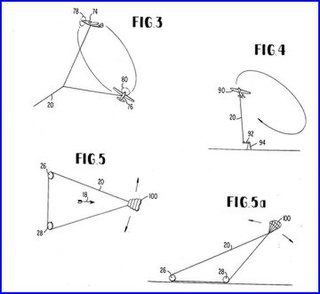
Crosswind kite power is power derived from airborne wind-energy conversion systems or crosswind kite power systems (CWKPS). The kite system is characterized by energy-harvesting parts flying transverse to the direction of the ambient wind, i.e., to crosswind mode; sometimes the entire wing set and tether set is flown in crosswind mode. From toy to power-grid-feeding sizes, these systems may be used as high-altitude wind power (HAWP) devices or low-altitude wind power (LAWP) devices without having to use towers. Flexible wings or rigid wings may be used in the kite system. A tethered wing, flying in crosswind at many times wind speed, harvests wind power from an area that exceeds the wing's total area by many times.
Wind assisted propulsion is the practice of decreasing the fuel consumption of a merchant vessel through the use of sails or some other wind capture device. Sails used to be the primary means of propelling ships, but with the advent of the steam engine and the diesel engine, sails came to be used for recreational sailing only. In recent years with increasing fuel costs and an increased focus on reducing emissions, there has been increased interest in harnessing the power of the wind to propel commercial ships.
Kite rigs are wind-assisted propulsion systems for propelling a vehicle. They differ from conventional sails in that they are flown from kite control lines, not supported by masts.




